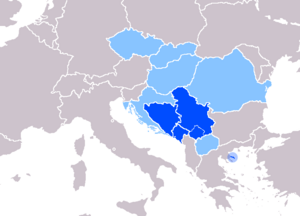Serbian language facts for kids
Quick facts for kids Serbian |
||||
|---|---|---|---|---|
| српски | ||||
| Native to | Serbia and neighboring regions | |||
| Native speakers | 12 million (date missing) | |||
| Language family |
Indo-European
|
|||
| Writing system | Cyrillic (Serbian alphabet) Latin (Gaj's alphabet) Serbian Braille |
|||
| Official status | ||||
| Official language in | ||||
| Recognised minority language in | ||||
| Regulated by | Board for Standardization of the Serbian Language | |||
| Linguasphere | part of 53-AAA-g | |||

Countries where Serbian is an official language. Countries where it is recognized as a minority language.
|
||||
|
||||
Serbian is a South Slavic language spoken mainly by Serbs. You can hear it in Serbia, Kosovo, Montenegro, and parts of nearby countries. Many Serbs living in other parts of the world, like Central Europe, North America, and Australia, also speak Serbian.
This language is part of the big Indo-European family of languages. It belongs to the Slavic group, which includes languages like Russian, Polish, and Croatian. Today, over 12 million people around the world speak Serbian.
Contents
What is the Serbian Language?
Serbian is a language with a rich history. It's known for using two different alphabets: Cyrillic and Latin. Both are used in Serbia, but Cyrillic is the official one. This makes Serbian unique among many languages.
How Serbian Changed Over Time
The Serbian language has changed a lot through history. In the mid-1800s, a famous Serbian linguist named Vuk Karadžić made big changes. He modernized the language from its older forms, which were spoken in the Middle Ages. His work helped make Serbian easier to learn and use.
Vuk Karadžić's changes were based on how people actually spoke. He believed that "write as you speak, and read as it is written." This idea helped to make the written language match the spoken language more closely.
Where is Serbian Spoken?
Serbian is the official language of Serbia and Bosnia and Herzegovina. It is also widely spoken in Montenegro, where it is one of the main languages. You'll also find many Serbian speakers in Croatia, North Macedonia, and Slovenia.
Beyond these countries, Serbian is spoken by many people who have moved to other parts of the world. Large communities of Serbian speakers live in countries like Germany, Austria, Canada, and the United States.
The Serbian Alphabet
As mentioned, Serbian uses two alphabets. The Serbian Cyrillic alphabet is based on the Cyrillic alphabet. It has 30 letters, and each letter represents one sound. This makes it very easy to learn how to read and write Serbian once you know the letters.
The other alphabet used is Gaj's Latin alphabet. This is a version of the Latin alphabet that also has 30 letters. It's often used in everyday life, especially online and in some media. Knowing both alphabets can be very helpful for Serbian speakers.
Images for kids
-
Miroslavljevo jevanđelje (The Gospel of Miroslav), a manuscript, c. 1186
See also
 In Spanish: Idioma serbio para niños
In Spanish: Idioma serbio para niños


